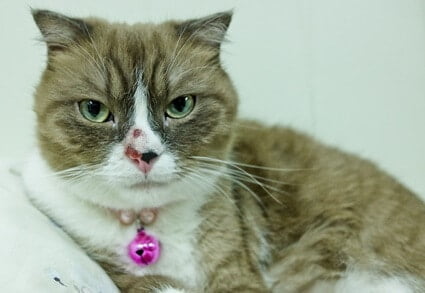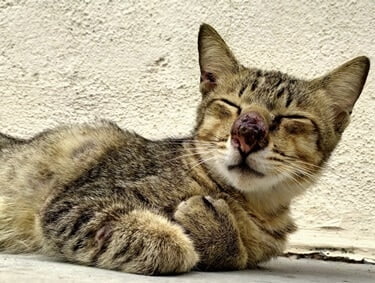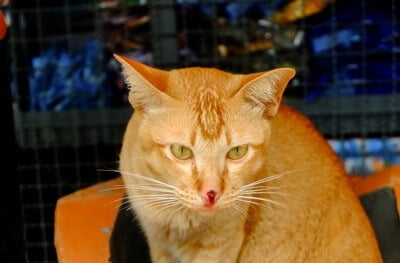Nosebleeds in cats are uncommon. There are two reasons why a cat will bleed from the nose. It may have experienced physical trauma, or a medical or environmental explanation (epistaxis) is responsible.
A cat’s nosebleed can be stoped with ice. Place ice in a plastic bag and wrap it in a cloth. Place this on the bridge of your cat’s nose to constrict the blood vessels. Before long, the bleeding will stop. Clean your cat’s nose to make sure that it does not swallow too much excess blood.
Cats can experience nosebleeds for a variety of reasons. Ice will stop a nosebleed in cats, but identifying the underlying cause is necessary.
Why Would A Cat Have a Nosebleed?
Blood will not necessarily pour from the nostrils of a feline. A nosebleed can be quite subtle. Signs that your cat’s nose is bleeding include:
- Nasal discharge with flecks of blood
- Bubbles from the nose
- Pawing at the nose
- Snorting
Understanding the cause of epistaxis can help you tailor a response to the bleeding. Examples include:
- Trauma to the nose
- Emotional stress
- Irritation or trapped foreign objects
- Dry air
- Upper respiratory infections
If you can identify why a cat’s nose is bleeding, you can take a situation-based approach to resolve it. Different causes of epistaxis require different, bespoke management, so we’ll explore each in turn.

Injury And Trauma
If your cat has experienced trauma, check for a cut on the nose. The blood may be flowing from the cut and not the nostrils. This could be caused by scratching with the claws or colliding with an object, such as a tree or fence.
If you find a wound, focus on reducing the bleeding from the nose. Apply pressure with a soft cloth or bandage. When the bleeding stops, gently dab at the wound. Do not wipe or drag, as doing so risks reopening the cut.
When the bleeding has stopped, seal the wound. If the cut is small, use a styptic pencil. This will sting, so restrain your cat’s paws. If the wound is larger than one centimeter, then stitches will be required.
Apply an antibiotic ointment to prevent the wound from becoming infected. Ensure the ointment is safe for consumption as your cat will not be able to resist licking the wound.
Stressful Situations
Emotional stress increases a cat’s heart rate, leading to spontaneous hypertension. According to the Journal of Veterinary Internal Medicine, epistaxis is often a symptom of high blood pressure in cats.
A stressed cat with a nosebleed must be calmed down as a matter of urgency. Bleeding from the nose will further aggravate the anxiety, so you must slow down your cat’s heart rate. Take the cat to a quiet room and offer some soothing words.
Creating this safe space is critical as this will separate the cat from any stress triggers. These could have been loud noises, inappropriate surroundings, or another pet in the cat’s territory. The cat will not start to calm down while still exposed to these stressors.
Ensure you do not grow upset yourself. According to Animal Cognition, cats recognize extreme human emotions. Your cat will assume that a heightened level of anxiety is an appropriate response to a nosebleed.
If you give your cat reason to be afraid, the nosebleed will only worsen. As a cat grows excited or frightened, its blood pressure will rise. This makes the blood rush to the head all over again, causing further bleeding.
Keep your cat as still as possible. The more your cat moves, the more it will bleed. If your cat enjoys time in a crate or carry bag, use this to control its movement. If not, wrap your cat in a towel.
Irritation and Foreign Objects
If your cat has a foreign object trapped in its nostrils, it may cause a nosebleed. This could be a blade of grass, a stone, or a household item. Until this object is removed, the nosebleed will continue unabated.
Removing a foreign object from a cat’s nostrils is difficult as the cat will fidget. Attempting to remove the object with tweezers can cause injury. This will aggravate nosebleeds, so a nasal endoscopy is safer.
Cat noses can also be irritated by breathing in irritants. Common examples include air fresheners, dust, and smoke. If your cat’s nose begins to bleed, relocate it to a room that’s free from irritants.
Stem the bleeding from your cat’s nose, if necessary. Ordinarily, this bleeding will stop naturally once exposure to the irritation ceases. Clear the rest of your home of whatever irritated your cat’s nose. Don’t allow your cat to re-enter the territory until it is safe to do so.
Dry Air Conditions
The membranes in your cat’s nose will become dry and irritable, forming crusts. If the cat sneezes as a result of this irritation, its nose will bleed.
Dry air is common during the winter months. Windows will be closed and central heating turned on, leading to an uncomfortable room temperature. Dry air can be reduced with a humidifier.
A room temperature above 75 degrees Fahrenheit risks causing a nosebleed. A cooling mat or damp towel should help to cool off your cat.
Once your cat is cooler, the nose will cease bleeding. Allow the blood to clot, then remove the build-up of crust inside the nostrils. Use a damp Q-Tip for this. If you push too hard, you risk aggravating the bleeding again.
Upper Respiratory Infection
If an older cat sneezes to excess, blood vessels in the nose will burst. Examples of upper respiratory infections include:
- Feline herpesvirus (FHV)
- Feline calicivirus (FCV)
- Bordetellosis
- Mycoplasma
- Chlamydophila
If a cat with a respiratory infection gets a nosebleed, move it to the bathroom. Close the door and run the hot taps to fill the lungs with steam. Breathing in steam eases the build-up of mucus in the nose. This, in turn, will lead to less sneezing and make treatment easier.
You can now stem the bleeding from your cat’s nose. With clearer airways, the epistaxis is less likely to return.

Medical Concerns
Medical explanations for epistaxis include:
- Consumption of toxins, such as rodent poison or pesticides
- Side effects of medications
- Blood disorders (anemia, hemophilia, or coagulopathy)
- Kidney failure
- Feline leukemia or cancerous growths
- Fungal infection
In the event of toxicity or a major medical issue, the cause must be treated. Nosebleeds are a symptom of a different complaint.
If your cat has developed nosebleeds after starting prescription medication, inform your vet as a change may be necessary. Nosebleeds are a sign that the cat’s body is rejecting the medicine.
Fungal infections are treated with topical infections. If your cat is taking antibiotics, the infection can gain a stranglehold. Wear gloves while clearing up your cat’s nosebleed as fungal infections can be zoonotic (passed from animal to human).
When your elderly cat’s nose stops bleeding, remove any traces of dried blood with a damp cloth as the smell of blood may upset your cat. Your cat may also lick its nose and swallow the blood.
It is possible that your cat swallowed blood. This will be visible in its stool or any vomit that follows the nosebleed. Swallowed blood in a cat’s waste will appear as black specks. This will go away in 24-48 hours.
How To Stop A Cat’s Nose Bleed
Never pinch a cat’s nose and tilt its head back. This will prevent a cat from breathing, and it may swallow blood. This can be a choking hazard.
Instead, apply ice to the bridge of the cat’s nose. The purpose of the ice is to constrict the blood vessels. This will slow, and eventually cease, the bleeding caused by high blood pressure. Do not cover the cat’s nostrils as this will restrict breathing, especially in brachycephalic breeds.
An icepack from a first aid kit will often be too large for a cat. Take ice cubes from your freezer and place them in a plastic bag. Wrap this bag in a thin washcloth or towel before applying it to the nose to prevent ice burn.
A nosebleed may appear painful, but never offer your cat human medication, such as aspirin. As the British Veterinary Journal explains, aspirin is toxic to cats and thins the blood. This can lead to anemia and uncontrolled bleeding.

